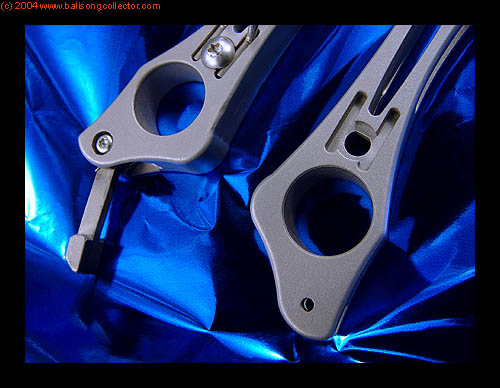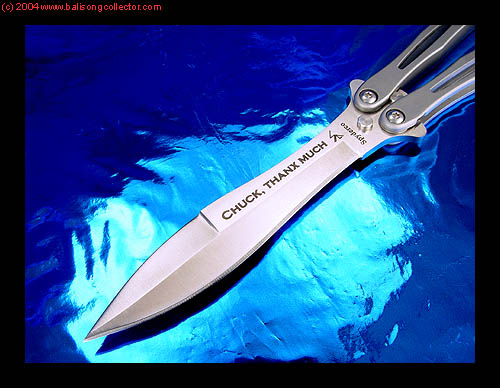
Spyderco invented the now-popular idea of a hole in the blade of a folding knife to assist opening. The Spyderfly actually has two. But, they're not on the blade, they're on the handles.

Using these holes, I'm certain that creative balisong artists are going to come up with all sorts of creative new techniques.
The blade is a modified spearpoint. This type of spearpoint is sometimes called a "leaf-style spearpoint," because it resembles the shape of some tree leaves.

The blade is made from 1/8"-thick
(3.175mm) VG-10 steel. VG-10 is a premium blade steel fully capable
of taking and retaining an excellent edge. Spyderco hardens it
to a Rockwell hardness ![]() of 59-60. The edge is flat-ground
and very sharp. Overall, the blade has a very nice brushed finish.
The grind lines are clean and distinct. The blade is very symmetric.
of 59-60. The edge is flat-ground
and very sharp. Overall, the blade has a very nice brushed finish.
The grind lines are clean and distinct. The blade is very symmetric.
Spyderco is famous for serrated edges. But the Spyderfly is currently only available with a "plain"edge. However, the edge on even the "plain-edge" Spyderfly is serrated. Spyderco believes in a serrated edge... even if the serrations are almost microscopic. Here's a small segment of the edge of the Spyderfly as seen very close up. The blade is photographed here sitting on a mirror so that you can also see the other side too.
Remember, you can click on any image to see a higher-resolution version. Each higher-resolution image opens in a new window.
This less-than-smooth edge, it's sometimes called "micro-serrations," actually makes the edge more durable and better for cutting fibrous material such as cloth, cardboard, paper, canvas, rope, plant materials, etc. It makes the edge better for "draw-cutting" than "push-cutting." My Spyderfly, when pushed up my arm, cut a few hairs but didn't exactly leave a bald spot. On the other hand, it slices through cardboard and rope quite nicely. This is a tradeoff that knife manufacturers have to make.
The spine has a swedge running half the overall length. The swedge is quite dull. It's about 5/100th of an inch (1.25mm) thick at the edge. If you want to sharpen the swedge and thus convert it into a false edge, it's not going to be easy. It's gonna take more than a few passes on a Sharpmaker to get from 5/100th of an inch to a sharp edge. On the other hand, this resolutely makes the Spyderfly a single-edged knife and clearly avoids legal restrictions on double-edged knives.
Spyderco choose a spearpoint-based blade profile for two reasons. First, it's very symmetric appearance compliments the symmetric handles making the Spyderfly simply look great. And, second, the symmetry of the spearpoint makes the blade perfectly balanced.
A true spearpoint is a fully double-edged blade. In a balisong, a full second edge means that there is no safe handle. That demands a much higher level of skill in manipulating the knife and renders many manipulation techniques impossible. So, Spyderco designed a modified spearpoint in which the spine had a half-length swedge. The long swedge captures most of the symmetric appearance and balance of a true spearpoint while avoiding the legal and manipulation implications of a true spearpoint. I think it's an excellent compromise.
The classic reason for a swedge is to improve a blade's performance in straight stabbing. The Spyderfly's swedge will certainly do that too.
The blade is secured to the handles by Chicago-screw-style pivot pins which can be adjusted by a T9 Torx driver. T9 is another uncommon Torx size that you're probably going to have to shop around a bit to find.

The joints have washers on both sides to reduce friction. Inserting a washer reduces wear by absorbing half of the wear itself and also reduces friction by creating two moving interfaces in parallel. If you add a lubricant, having a washer in the joint will mean that there are now two layers of lubricant instead of one.

I don't often find it necessary to disassemble the joints on my balisongs. Balisong joint is open enough that any dirt or "gunk" that might build up can be flushed out with an aerosol solvent without taking the time and effort to disassemble the joints. The Spyderfly is all-metal so you don't have to worry about most solvents damaging the knife.
Please note that, "Spyderco’s warranty does not cover damage caused by... disassembly ..." I'm assuming that Spyderco does not consider moving the clip or the latch to be disassembly since they touted both of these as Spyderfly features. But disassembling the joints may be a no-no under the warranty.
But, let's throw caution (and my warranty) to the wind and get the Torx wrenches out.

The Spyderfly disassembles easily. The female side of the Chicago Screw pushes right out of the handle with only manual pressure. It's nice to know that you can disassemble the joints is if they get something in them that can't be easily flushed out such as hardened paint.
At first glance, there's nothing innovative here. There's a Chicago Screw, two washers, and an ordinary bushing. But, look at the female component of the Chicago Screw. One side is flattened. Look at the hole in the handle. It has a corresponding flat side. This keeps the Chicago Screw from spinning in the handle either during manipulation or during disassembly. That's a nice, clever addition.
You can certainly see the
generous dose of blue thread locking adhesive ![]() in the picture
above. It's difficult to see in the small picture, though, to
see that there's also a dab of something red on the very end of
the screw. You can see it better in the large version of the picture.
Just click on the small picture to see the large picture. It doesn't
look like thread locking adhesive to me. I don't know what it
is.
in the picture
above. It's difficult to see in the small picture, though, to
see that there's also a dab of something red on the very end of
the screw. You can see it better in the large version of the picture.
Just click on the small picture to see the large picture. It doesn't
look like thread locking adhesive to me. I don't know what it
is.
My Spyderfly came out of the box just a little bit tight. It took just a tweak with a Torx wrench to get it swinging nicely. I'm pleased to report that when the Spyderfly's pivots are adjusted for free manipulation, there is only the very slightest blade wobble.
The Spyderfly comes from the factory with some bit of what seems to be a conventional oil. You can see it in the picture above.
I, of course, suggest a
drop or two of Militec-1 ![]() .
The Spyderfly's washers appear to be standard stainless steel.
I'm certain that, given the easy of disassembling the Spyderfly's
joints -- warranty or not -- some people will want to replace
the standard washers with Phosphor-Bronze after-market washers.
.
The Spyderfly's washers appear to be standard stainless steel.
I'm certain that, given the easy of disassembling the Spyderfly's
joints -- warranty or not -- some people will want to replace
the standard washers with Phosphor-Bronze after-market washers.
Click on the Spyderco logo below to continue:
